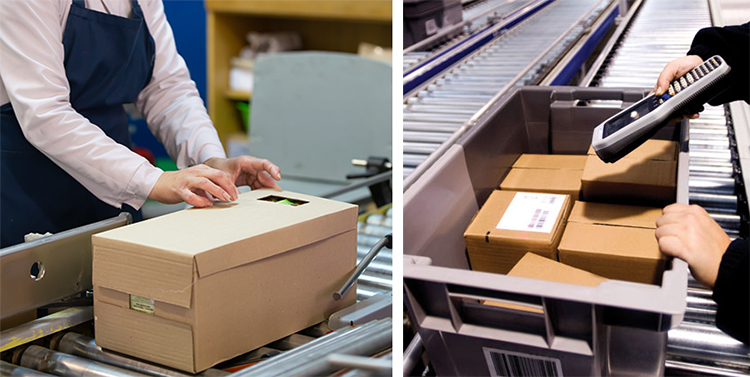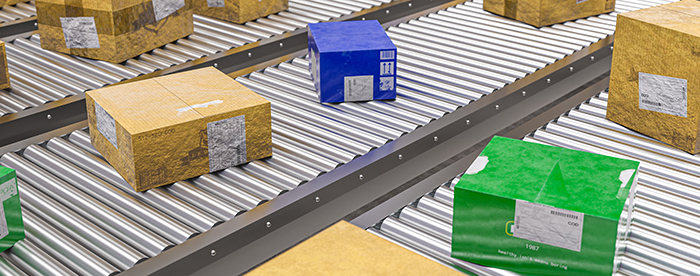Picking to Cartons vs. Picking to Totes
Picking strategies for order fulfillment

In a pick-to-tote operation, you have the advantage of a dedicated packing function that allows more precise packaging and evaluation of order quality. That added quality comes at a price, however: floor space, time, labor and dollars. Can the same functions be executed in a pick-to-carton operation?
Since totes can be “one size (or a range of them) fits all”, your pickers can easily pick and organize totes as they navigate the system, either on conveyor or in carts. Trained packers at the end of the line “cartonize” the orders, often using state-of-the-art packing stations and consolidated equipment & materials. This means that you’ll have at least two employees touching each order and that the packing group will need more square footage.
What if you decided to pick directly to cartons, eliminating the totes and reducing or eliminating the packing group?
Switching to a pick-to-carton system
Pick to carton can save costs on materials, picking and packing labor, reduce additional handling and improve customer experience, but only when done correctly.
Depending on your equipment and process it may not be possible to switch to carton picking without significant changes.
- Carton picking can save totes, time, and money.
- Packaging and QC requirements at the end of the line may be reduced.
- Carton picking allows you to automate some quality control and packaging functions.
Switching to carton picking can either be a blessing or a curse. Here’s how to make sure your operation is suitable and successful for carton picking:
(1) Make sure picking to cartons is compatible with your equipment and process
If you’re using a conveyor system with diverts or sortation, picking to cartons may not make sense.
Mis-routing and carton damage are more likely the more the carton diverges, sorts or accumulated. This isn’t to say that conveyors are incompatible with carton picking–they aren’t–but you must understand your load, the status of it as it conveys and its limits before you proceed.
(2) Stick your toe into the water
Start with a single line or product mix, where it’s simpler to pick to carton. As your pickers learn the ropes, expand the process to more complex orders and more picking lines. If you can do it without increasing errors the first time, the odds are that you can expand the program successfully.
 (3) Know your product sizes
(3) Know your product sizes
Your WMS systems must have good information on pick sizes for most every picking operation, but this is even more important for carton picking. Extensive size profiles help you avoid repackaging when the carton size chosen for the order isn’t the right one.
(4) Your best packers should be first “at bat”
When the order is in front of the packer at the end of a line, the first picker can evaluate the order, all of its contents and the necessary carton to pack it as efficiently as possible.
- Picking to the carton is essentially picking on the fly, and if it’s passing between pick zones, different pickers will be building the carton.
- Order mix is going to play a part. That first picker/packer must make good decisions when the carton is selected to prevent downline problems.
- Your WMS may be able to help determine carton size if all dimensional data is known.
(5) Simple is likely to work best
High-volume product groupings with minimal size variances are great applications for carton picking. If you have a large mix of products and product sizes, then you’ll need to constantly analyze your product mix to be sure you can execute carton picking as new SKU’s come into play.
(6) Pick your “base” (larger, heavier) products first
The arrangement of picking areas must be configured so that larger items are picked first in the process, so they can be packed to the bottom of the carton. Pickers should not be constantly re-arranging the carton as it moves — or at least they should minimally need to do that. Heavier, bulkier home items should be picked first before moving into zones where smaller, more fragile products should be picked.
(7) Watch for crushed case edges
If you’re handling cartons more often, so the chances that they will get crimped, torn, or squashed increase. If necessary, use higher-quality cartons to alleviate this problem. Since these cartons are often shipped to customers, that damage can be important.

(8) Consolidate your box sizes
This is a good idea, anyway as it reduces costs for carton re-ordering and storage.
If you can cube all of your products to fit into a range of carton sizes, you greatly simplify the process. This makes picking decisions simpler for everyone involved. Carton erectors may be used to build custom sizes, although this is typically done in tote picking operations rather than prior to cartons being inducted into a system.
(9) Speaking of carton sizes, keep your conveyor in mind
Every carton you intend to convey must work on all of your transport conveyors. If you’re using roller conveyors, box widths should be 2″ less than the roller width. You should always have at least three rollers under each carton in a roller system to prevent tipping and jams.
With advances in conveyor design, you can convey larger, heavier products than ever
(10) Factor in all the costs:
Eliminating or reducing a packing department and its associated costs sounds good, but the pitfalls are real.
You should understand your carton, product, and order sizes, and the effect future changes may have on those. You may need specialized over-conveyor workstations. The cost of carton fill is very real, and if this results in looser cartons, then that cost can increase. Some items that were previously in poly bags might have to be cartonized prior to being packed.
It’s all about the way orders flow and picking systems are coordinated
It’s best to design your operations as a carton pick or tote pick from the very start, but it’s also possible to switch as your needs change. Mixing the methodology is acceptable, as you can squeeze savings from more uniform, less challenging pick lines and retain the advantages of pick-to-tote for complex picks.
Scott Stone is Cisco-Eagle's Vice President of Marketing with 35 years of experience in material handling, warehousing and industrial operations. His work is published in multiple industry journals an websites on a variety of warehousing topics. He writes about automation, warehousing, safety, manufacturing and other areas of concern for industrial operations and those who operate them.




 (3) Know your product sizes
(3) Know your product sizes